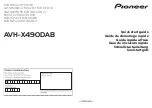
User Manual
© 2017 Inertial Sense, LLC
4
11/30/2017
1
Overview
The µINS GPS aided Inertial Navigation System, µAHRS Attitude Heading Reference System, and the µIMU Inertial
Measurement Unit monitor many different types of measurements including rotation, acceleration, GPS position,
magnetic flux density, pressure and velocity. The Inertial Sense SDK provides a software interface to allow
communication with the device including setting configuration options, retrieving specific data, and listening for
data broadcasts.
For example, you could configure the device to broadcast the current latitude, longitude, and altitude as well as
the heading and velocity at up to 500Hz. This manual will cover the underlying protocol and message format
(binary and ASCII) involved in communicating with the device, along with a C, C++ and C# binding.
1.1
Description of differences between IMU, AHRS, INS
The
μIMU
™ is a miniature calibrated sensor module consisting of
an Inertial Measurement Unit (IMU),
magnetometer, barometer, and L1 GPS (GNSS) receiver. Data out includes angular rate, linear acceleration,
magnetic field, barometric altitude, and GPS WGS84 geo-position. All systems include a comprehensive sensor
calibration for bias, scale-factor, and cross-axis alignment, minimizing manufacturing variation and maximizing
system performance.
The
μAHRS
™ is an
Attitude Heading Reference System (AHRS) that includes
all functionality of the μIMU™ and
fuses IMU and magnetometer data to estimate roll, pitch, and heading.
The
μINS
™ is a GPS (GNSS) aided
inertial navigation system (GPS-INS) module that includes all functionality of the
μIMU™
and provides orientation, velocity, and position. Sensor data from MEMs gyros, accelerometers,
magnetometers, barometric pressure, and GPS/GNSS is fused to provide optimal measurement estimation.





































